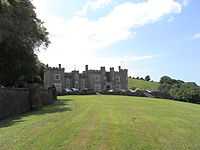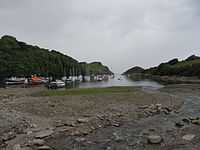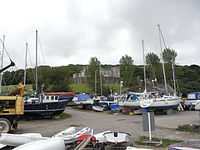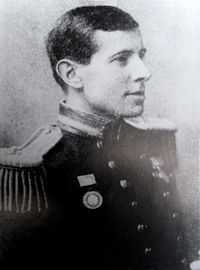Watermouth Castle
| Watermouth Castle | |
|---|---|
 Watermouth Castle and Watermouth Bay | |
| Location | Watermouth, Devon, England |
| Coordinates | 51°12′48″N 4°04′49″W / 51.21333°N 4.08028°WCoordinates: 51°12′48″N 4°04′49″W / 51.21333°N 4.08028°W |
| Built | 1825 |
| Architect | George Wightwick |
Listed Building – Grade II* | |
| Designated | 9 March 1953[2] |
| Reference No. | 97006 |
 Location of Watermouth Castle in Devon
| |


Watermouth Castle is a building in Watermouth, near Ilfracombe, North Devon, England, designed by George Wightwick as a residence for the Bassett family in the mid-19th century and is not a true castle but a country house built to resemble one. It has been designated as a Grade II* listed building.[2]
Located near the shore of the inlet of Watermouth, near Ilfracombe, Devon, the castle houses a collection of Victorian antiques centred around domestic tools and amusement machines, a family theme park and holiday apartments.[3] The Bassetts left the castle in 1945.
Descent of ownership
Bassett
Joseph Davie Bassett

The Castle was built by Joseph Davie Bassett (1764-10 December 1846), son of John Davie (d.1793) of Orleigh Court, Buckland Brewer, (3rd in descent from the Bideford tobacco merchant John Davie (d.1710) of Orleigh Court, Buckland Brewer) by his wife Eleanora Basset of Heanton Court, Heanton Punchardon. His brother was Rev. Charles Davie (1760–1836),[4] rector of Heanton Punchardon, which advowson was possessed by the Bassett family. After his mother became the sole heiress of her childless brother Francis Basset (d.1802), son of John Francis Bassett (1714–1757), MP for Barnstaple 1740-1 by his wife Eleanor Courtenay (d.1765), daughter of Sir William Courtenay, 2nd Baronet (d.1735) of Powderham, Joseph Davie adopted the name Bassett in lieu of his patronymic and adopted the Bassett armorials. He sold Orleigh in 1807 and built Watermouth Castle as his principal residence.[5] He married Mary Irwin (1777-21/4/1862) of Barnstaple. The couple's mural monument exists in Berrynarbor Church.
Visit of John Swete



The Devon topographer Rev. John Swete visited Watermouth, before the construction of the Georgian castle, as part of his travels in 1796, and was entertained by Mr Davie. He painted the Palladian house then standing on the site and recorded the visit in his journal as follows:[6]
"From the summit of a high promontory, the verge of which we skirted, I began to descend towards Watermouth, the view of which was as singular as it was pleasing. The whole of these grounds was circumscribed to a small space, consisting of a few fields contiguous to the house and a headland which when it became included between the waters of the cove and the sea was at first of some width, and good pasture ground. This however soon contracted itself and narrowing by degrees, at length terminated toward the west in a rocky point, which trusting itself into the sea opposite to a vast cliff which descended steep and craggy on the other side, formed the mouth of the little cove whose beauty and singularity were the boast of the place. At this point it was very contracted; the space however between the rocky barriers became extended as it made its advances inland and was the widest at its extremity where a cluster of fishing cots were seen and where on a more remote elevated knoll the seat of Mr Davie was placed. The preceding sketch will better explain the nature of the cove and the headlands which include it and it will also convey a juster idea of the situation and architecture of the house. This however I found in a dilapidated state to which it was intentionally reduced with the view of its enlargement. I had just finished a hasty outline of it when a servant brought me the comp(limen)ts of his master, requesting me to partake of his dinner which was then on the table. It was three O'Clock and the invitation being pressing I accepted it and following the servant to the fishing cot below, where Mr Davie had (during the alteration of his house) taken up his temporary abode, I met with a friendly and polite reception. In the evening after we had finished our wine he and his brother accompanied me to the house, which I found was only to have additions made to it, the chief of which were to be two bow-windows towards the north and south aspects; these were the principal rooms, drawing and eating room. They were at present small and from the proposed plan it appeared that there would be not only an accession to the size but to the prospect. Almost the only one that had been commanded from the windows had been restricted to the cove and its surrounding accompanyments but to this there would now from the northern bow be a vast acquisition; for the whole of the Combemartyn coast would be taken in to the view and in particular the pointed hill which I had almost termed a mountain, before noticed under the title of "Hangman's Cliff". There was a degree of grandeur here which approached toward sublimity and, as it was in considerable contrast to the views of the cove, could not fail of attracting the eye of a Man of Taste, such as Mr Davie appeared to me. Indeed the introduction of this fine point to the other views from the house seemed to me of the first consequence and it was a matter of astonishment that the whole of the house towards this quarter should have been blank. The original building was in itself small and singular in that it had a kind of monastic alley underground where the offices were placed and around which it wound in a variety of labarynthine turnings. On a plan of Lord Clinton's [7] (Mr Davie told me), who was a relative of the family, it had been raised. This gentleman having travelled had been so caught by the Grecian style of architecture that on his return to England he became possessed of a rage for building and introducing to his countrymen in the West, specimens of the elegant temples and edifices which he had met with abroad and had admired. Vitruvius and Palladio were his great masters and from their models arose the temples at Castle Hill, his place of residence, and the little mansion at Watermouth. In the environs of London we not infrequently meet with seats of such a cast but surprise at least is excited in the view of such sort of architecture in the middle of a wild country. One might have rather expected to have beheld an old gothic mansion as being more appropriated to the country and romantic situations of Watermouth".
Joseph Davie Bassett monument

The mural monument to Joseph Davie Bassett (1764–1846), builder of Watermouth Castle, his wife and two infant children is situated at the east end of the south aisle wall in Berrynarbor Church. On a roundel in the centre is inscribed the following:
"Sacred to the memory of Joseph Davie Bassett Esq.r of Watermouth who died the 10th December 1846 aged 82 years. Also Joseph Davie Bassett son of the above who died the 1st May 1812 aged 2 years and 6 months. Also Eleanora Davie Bassett who died the 17th March 1813 aged 1 year and 10 months. Also Mary Davie Bassett widow of the above who died the 21st April 1862 aged 85 years".
Davie Bassett descendants


His eldest son and heir was Arthur Davie Bassett (1801 - 8 December 1870), who died in a horse-riding accident. He married Harriet Sarah Crawfurth, daughter of Thomas Smith Crawfurth of Dulverton, by whom he had his eldest surviving son Reverend Arthur Crawfurth Davie Bassett (1830–1880), who was unmarried and died at Watermouth Castle. He had a brother who had died as an infant aged under 1 year in 1839, Francis Courtenay Bassett, and two sisters, Harriet, whom he made his heir, and Eleanora Susanna Bassett (1842–1881), who died unmarried and in whose memory a stained-glass window was erected in Berrynarbor Church. His heir was thus his sister Harriet Mary Bassett, who became on 7 January 1858 the wife of Charles Henry Williams (1834–1908), MP, of Pilton House, Pilton, near Barnstaple.
Williams Bassett

The Williams family is memorialised by the Williams Arms public house in the parish of Heanton Punchardon, on the road between Barnstaple and Braunton. As a condition of his wife's inheritance in 1880 Charles Henry Williams assumed for himself, his wife and their progeny by Royal License dated 11 October 1880 the surname of Basset in lieu of his patronymic, with the arms of Basset:[8]
"London Gazette, 15 October 1880; Whitehall October 11, 1880
The Queen has been pleased to grant unto Charles Henry Williams of Pilton House, in the parish of Barnstaple, in the county of Devon, Esq., and to Harriet Mary, his wife, elder of the two daughters of Arthur Davie-Basset of Umberleigh, in the parish of Atherington, and Watermouth Castle in the parish of Berrynarbor, both in the county of Devon, and sister and co-heir of Arthur Crawfurth Davie-Basset of Umberleigh and Watermouth Castle aforesaid, a clerk in Holy Orders, all deceased, her Royal Licence and authority that they may take and henceforth use the surname of Bassett only instead of that of Williams, and that he, the said Charles Henry Williams, may bear the arms of Bassett and that such surname and arms may in like manner be taken, borne and used by the issue of their marriage; such arms being first duly exemplified according to the laws of arms and recorded in the College of Arms, otherwise the said Royal Licence and permission to be void and of none effect. And to command that the said Royal concession and declaration be recorded in Her Majesty's said College of Arms".
New Williams Bassett arms

The armorial bearings he adopted were as follows: Barry wavy of six or and gules in the centre chief point a cross crosslet of the last Crest: on a wreath of the colours, a unicorn's head couped argent,the mane, beard, and horn or, on the neck two bars indented gules, and charged for distinction with a cross crosslet also gules. Motto: Bene agere ac Laetari ("Act well and rejoice"). His estates were at Pilton House, Barnstaple; Umberleigh House, Atherington; and Watermouth Castle, Berrynarbor, all in Devon. [9][10][11]
Williams Bassett descendants
They had the following progeny:

- Walter Bassett Bassett (1864–1907), (born Walter Basset Williams), Lieutenant RN, an engineer who was a pioneer in the manufacture of ferris wheels but died almost bankrupt. He predeceased his father so never inherited the family estates. He built the Wiener Riesenrad ("Vienna Giant Wheel") in Vienna in 1897, still standing in 2012, for many years the largest in the world, to celebrate the Golden Jubilee of Emperor Franz Josef I of Austria. He married on 18 November 1890 Ellen Caroline Charlotte Dowell, daughter of Admiral Sir William Montagu Dowell. They had no progeny.
- Edith Bassett Bassett (1862–1943) (born Edith Basset Williams), married on 18 October 1882 at the Curzon Chapel in Mayfair, London, Captain Ernest Charles Penn Curzon (1856–1938), son of Col. Hon. Ernest George Curzon, son of Richard William Penn Curzon-Howe, 1st Earl Howe. She was awarded the CBE in 1918. They had one son and two daughters. Following her father's death in 1908, she inherited from him all the Bassett estates, including Watermouth Castle and the manor of Berrynarbor. During World War I she started to sell off the ancient Basset lands, including Umberleigh House and manor in 1917. Watermouth Castle had been used as a military hospital during WW I, and in the 1920s she started to sell the Berrynarbor farms and cottages. In 1942 she sold most of the contents of Watermouth Castle.[12] In 2012 her portrait still hangs in Manor Hall (the Village Hall), Berrynarbor.
Wickenden
The Castle passed through the hands of many short-term owners and property speculators but was at last purchased by Keith Wickenden (1932–1983), a Conservative MP for Dorking South and Chairman and major shareholder in European Ferries, the holding company for Townsend Thoresen Ferries and owner of Watermouth Harbour and a director of Bromwich Albion Football Club. He was killed in a light aircraft crash near Shoreham Airport in 1983. Keith and his brother Roland had taken over George Nott Industries in about 1970.[13] His brothers and heirs sold out to P&O Ferries in 1987, just before the Herald of Free Enterprise disaster off Zeebrugge. His brother Alan Wickenden (b. 1937) managed for him a holiday camp in North Devon until the early 1980s. He retired to Guernsey where he ran into financial difficulties following a failed business venture in Majorca in which he lost about £450,000 and was forced to sell the family home in Guernsey and move to Down St Mary, near Crediton, Devon. He was jailed in 2004 for 4 years for manslaughter by reason of diminished responsibility of his 69 year-old wife Janet to whom he had been married for 46 years, which act he committed on 13 November 2003 in a lay-by on the A396 Exeter to Tiverton road. His reason was that his wife was preventing the sale of his £500,000 house.[14] [15]
Haines
Watermouth Castle was purchased from Wickenden in 1977 by Richard L. Haines of Market Deeping, Cambridgeshire and his Dutch-born wife, the daughter of a flower-bulb grower and nurseryman named Derick Van Daalen. The price paid for the Castle and 60 acres was £50,000. The Castle was turned by them into an amusement centre, which is currently run in 2012 by their two sons Jonathan and Antonie Haines.
References
- ↑ Rogers, W.H. "Buckland Brewer" (1938), pp.53-4
- ↑ 2.0 2.1 "Watermouth Castle, including front - retaining wall and rear courtyard". Images of England. English Heritage. Retrieved 2009-08-06.
- ↑ "Picture".
- ↑ Heanton Punchardon Church burials file displayed in church. Charles Davie was buried 12/2/1836 aged 76
- ↑ Rogers, W.H. Buckland Brewer, 1938, pp.52-3
- ↑ Gray, Todd & Rowe, Margery (Eds.), Travels in Georgian Devon: The Illustrated Journals of the Reverend John Swete, 1789-1800, vol.3, Tiverton, 1999, pp.86-8
- ↑ Hugh Fortescue, 1st Earl of Clinton, 14th Baron Clinton (1696–1751)
- ↑ London Gazette, 15 October 1880, p.5285
- ↑ Fox-Davies, Arthur Charles. Armorial families: a Directory of Gentlemen of Coat-Armour
- ↑ Everard, P., p.31
- ↑ said (erroneously) to have been the grandson of "Colonel Bassett", Master 1775-1784, the above two possible identities for whom however had no male progeny, making such relationship impossible. (Lee, Author Rawdon Briggs, A History And Description Of The Modern Dogs Of Great Britain And Ireland (Sporting Division), 1897)
- ↑
- ↑ Obituary in Accountancy Magazine, August 1983
- ↑ http://news.bbc.co.uk/1/hi/england/devon/3594843.stm
- ↑ http://www.thisisguernsey.com/latest/2004/04/03/uk-wife-killer-lived-in-st-martins-for-12-years/